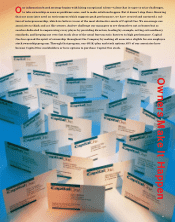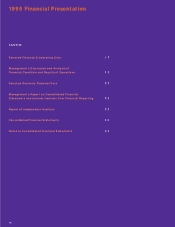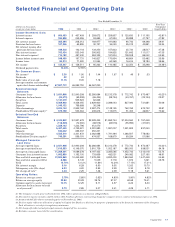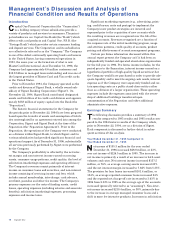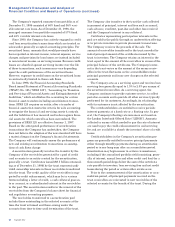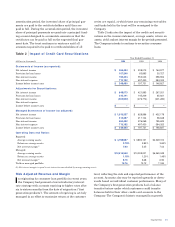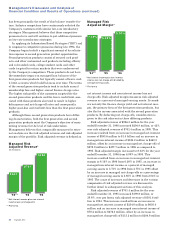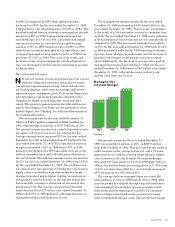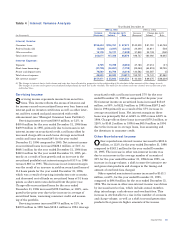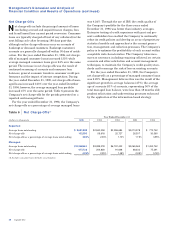Capital One 1996 Annual Report Download - page 20
Download and view the complete annual report
Please find page 20 of the 1996 Capital One annual report below. You can navigate through the pages in the report by either clicking on the pages listed below, or by using the keyword search tool below to find specific information within the annual report.Capital One
Management’s Discussion and Analysis of
Financial Condition and Results of Operations
18
Introduction
Capital One Financial Corporation (the “Corporation”)
is a holding company whose subsidiaries provide a
variety of products and services to consumers. The princi-
pal subsidiaries are Capital One Bank (the “Bank”) which
offers credit card products and Capital One, F.S.B. (the
“Savings Bank”) which provides certain consumer lending
and deposit services. The Corporation and its subsidiaries
are collectively referred to as the “Company.” The Company
is one of the oldest continually operating bank card issuers
in the United States, having commenced operations in
1953, the same year as the formation of what is now
MasterCard International. As of December 31, 1996, the
Company had approximately 8.6 million customers and
$12.8 billion in managed loans outstanding and was one of
the largest providers of MasterCard and Visa credit cards
in the United States.
Prior to November 1994, the Company operated as the
credit card division of Signet Bank, a wholly owned sub-
sidiary of Signet Banking Corporation (“Signet”). On
November 22, 1994, Signet Bank contributed designated
assets and liabilities of its credit card division and approxi-
mately $358 million of equity capital into the Bank (the
“Separation”).
The historic financial statements for the Company for
the periods prior to November 22, 1994 have been prepared
based upon the transfer of assets and assumption of liabili-
ties contemplated by an agreement entered into among the
Corporation, Signet and Signet Bank at the time of the
Separation (the “Separation Agreement”). Prior to the
Separation, the operations of the Company were conducted
as a division within Signet Bank, to which Signet and its
various subsidiaries had provided significant financial and
operational support. As of December 31, 1996, substantially
all services previously performed by Signet were performed
by the Company.
The Company’s profitability is affected by the net inter-
est margin and non-interest income earned on earning
assets, consumer usage patterns, credit quality, the level of
solicitation (marketing) expenses and operating efficiency.
The Company’s revenues consist primarily of interest
income on consumer loans and securities, and non-interest
income consisting of servicing income and fees, which
include annual membership, interchange, cash advance,
overlimit, past-due and other fee income. The Company’s
primary expenses are the costs of funding assets, credit
losses, operating expenses (including salaries and associate
benefits), solicitation (marketing) expenses, processing
expenses and income taxes.
Significant marketing expenses (e.g., advertising, print-
ing, credit bureau costs and postage) to implement the
Company’s new product strategies are incurred and
expensed prior to the acquisition of new accounts while
the resulting revenues are recognized over the life of the
acquired accounts. Revenues recognized are a function of
the response rate of the initial marketing program, usage
and attrition patterns, credit quality of accounts, product
pricing and effectiveness of account management programs.
Certain pro forma information discussed within this
annual report present the Company as if it had been an
independently funded and operated stand-alone organization
for the full year in 1994. Pro forma income includes, for the
period prior to the Separation, interest income earned on a
hypothetical portfolio of high-quality liquid securities that
the Company would have purchased in order to provide ade-
quate liquidity and to meet its ongoing cash needs, interest
expense as if the Company were separately funded and cer-
tain operating costs as a public stand-alone entity rather
than as a division of a larger organization. These operating
expenses include the expenses associated with the owner-
ship of additional buildings transferred upon
consummation of the Separation and other additional
administrative expenses.
Earnings Summary
The following discussion provides a summary of 1996
results compared to 1995 results and 1995 results com-
pared to the 1994 historic results of the Company which,
prior to November 22, 1994, are as a division of Signet.
Each component is discussed in further detail in subse-
quent sections of this analysis.
Year Ended December 31, 1996 Compared to
Year Ended December 31, 1995
Net income of $155.3 million for the year ended
December 31, 1996 increased $28.8 million, or 23%,
over net income of $126.5 million in 1995. The increase in
net income is primarily a result of an increase in both asset
volumes and rates. Net interest income increased $157.5
million, or 76%, as average earning assets increased 23%
and the net interest margin increased to 7.62% from 5.35%.
The provision for loan losses increased $101.4 million, or
154%, as average reported consumer loans increased 24%
and the reported net charge-off rate increased to 3.63% in
1996 from 2.03% in 1995 as the average age of the accounts
increased (generally referred to as “seasoning”). Non-inter-
est income increased $210.4 million, or 38%, primarily due
to the increase in average managed consumer loans and a
shift to more fee intensive products. Increases in solicitation





